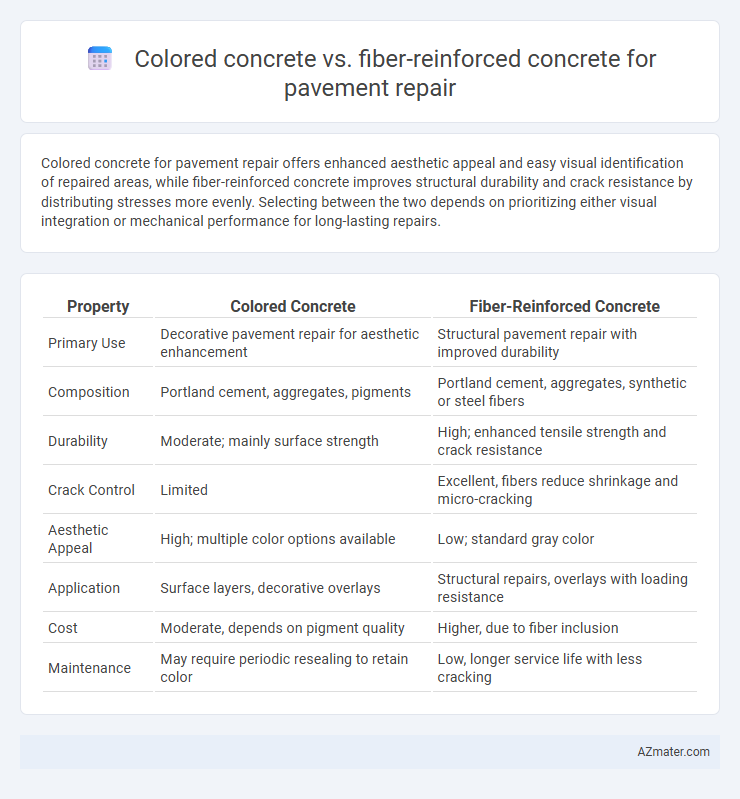Colored concrete for pavement repair offers enhanced aesthetic appeal and easy visual identification of repaired areas, while fiber-reinforced concrete improves structural durability and crack resistance by distributing stresses more evenly. Selecting between the two depends on prioritizing either visual integration or mechanical performance for long-lasting repairs.
Table of Comparison
| Property | Colored Concrete | Fiber-Reinforced Concrete |
|---|---|---|
| Primary Use | Decorative pavement repair for aesthetic enhancement | Structural pavement repair with improved durability |
| Composition | Portland cement, aggregates, pigments | Portland cement, aggregates, synthetic or steel fibers |
| Durability | Moderate; mainly surface strength | High; enhanced tensile strength and crack resistance |
| Crack Control | Limited | Excellent, fibers reduce shrinkage and micro-cracking |
| Aesthetic Appeal | High; multiple color options available | Low; standard gray color |
| Application | Surface layers, decorative overlays | Structural repairs, overlays with loading resistance |
| Cost | Moderate, depends on pigment quality | Higher, due to fiber inclusion |
| Maintenance | May require periodic resealing to retain color | Low, longer service life with less cracking |
Introduction to Pavement Repair Solutions
Colored concrete enhances pavement aesthetics and provides durable surface options with customizable pigments, making it ideal for visible repairs in urban infrastructure. Fiber-reinforced concrete incorporates synthetic or steel fibers to improve tensile strength, crack resistance, and durability, offering robust performance in high-stress pavement repairs. Both materials contribute to extending pavement lifespan, with colored concrete emphasizing visual appeal and fiber-reinforced concrete focusing on structural resilience.
Overview of Colored Concrete
Colored concrete enhances pavement repair by integrating pigments directly into the mix, offering durable, aesthetically pleasing surfaces that resist fading and wear. It provides a versatile range of colors and finishes suitable for urban environments where visual appeal and functional performance are critical. This type of concrete maintains structural integrity while allowing for creative design options in roadways, sidewalks, and plazas.
Overview of Fiber-Reinforced Concrete
Fiber-reinforced concrete (FRC) incorporates synthetic or steel fibers into the concrete mix, enhancing tensile strength, durability, and crack resistance, which is critical for pavement repair applications. Unlike colored concrete primarily used for aesthetic appeal, FRC provides superior structural performance by distributing stresses more evenly across the pavement surface. This reinforcement reduces maintenance frequency and extends the service life of repaired pavements under heavy traffic loads and environmental stressors.
Key Differences Between Colored and Fiber-Reinforced Concrete
Colored concrete enhances pavement repair aesthetics by incorporating pigments for durable, visually appealing surfaces, while fiber-reinforced concrete improves structural integrity through embedded synthetic or steel fibers that increase tensile strength and crack resistance. Colored concrete primarily addresses surface appearance and customization, whereas fiber-reinforced concrete focuses on mechanical performance and long-term durability under heavy traffic loads. Selection depends on project priorities: aesthetic value versus enhanced load-bearing capacity and reduced maintenance needs.
Aesthetic Benefits of Colored Concrete
Colored concrete enhances pavement repair projects by providing versatile aesthetic options that can be tailored to match surrounding landscapes or design themes, improving visual integration and curb appeal. The pigmentation in colored concrete allows for uniform coloration and long-lasting vibrancy, offering a more visually appealing alternative to traditional gray concrete surfaces. This aesthetic advantage supports community beautification efforts while maintaining the functional durability required for pavement repair.
Structural Advantages of Fiber-Reinforced Concrete
Fiber-reinforced concrete (FRC) offers superior structural advantages for pavement repair by significantly enhancing tensile strength and crack resistance compared to colored concrete. The addition of synthetic or steel fibers reduces shrinkage and improves impact and fatigue durability, leading to longer-lasting repairs under heavy traffic loads. These properties make FRC an optimal choice for pavements requiring high performance and reduced maintenance frequency.
Durability and Longevity in Pavement Repairs
Colored concrete enhances pavement repair durability by providing UV resistance and thermal stability, reducing surface cracking and spalling. Fiber-reinforced concrete improves longevity through superior tensile strength and crack control, distributing stresses evenly and preventing premature failure. Both materials extend pavement lifespan, with fiber-reinforced concrete particularly effective in heavy traffic conditions and colored concrete offering aesthetic durability for visible repair areas.
Installation Process Comparison
Colored concrete for pavement repair typically involves mixing pigments with the cementitious material before placement, requiring precise calibration to achieve uniform coloration and ensure visual consistency. Fiber-reinforced concrete incorporates synthetic or steel fibers into the mix, demanding thorough blending to distribute fibers evenly, which enhances tensile strength and crack resistance but does not affect coloration. Installation of colored concrete emphasizes aesthetic control and curing conditions to prevent color variation, while fiber-reinforced concrete prioritizes mechanical performance and proper consolidation to maximize fiber effectiveness in structural reinforcement.
Cost Analysis: Colored vs Fiber-Reinforced Concrete
Colored concrete typically incurs higher upfront costs due to pigment additives and specialized mixing processes, whereas fiber-reinforced concrete demands moderate investment for polymer or steel fibers that enhance tensile strength. Life-cycle cost analysis often favors fiber-reinforced concrete because its improved durability reduces maintenance and repair frequency over time, offsetting initial expenses. Selecting between colored and fiber-reinforced concrete for pavement repair depends on balancing aesthetic requirements against long-term performance and maintenance budget constraints.
Best Applications and Recommendations
Colored concrete offers aesthetic benefits and is ideal for decorative pavement repairs in plazas, walkways, and residential driveways where visual appeal is prioritized. Fiber-reinforced concrete provides enhanced durability, crack resistance, and load-bearing capacity, making it best suited for high-traffic roads, industrial pavements, and heavy-duty repair projects. For optimal results, colored concrete is recommended for surface-level repairs requiring design integration, while fiber-reinforced concrete should be used in structural repairs demanding long-term strength and minimized maintenance.

Infographic: Colored concrete vs Fiber-reinforced concrete for Pavement Repair
 azmater.com
azmater.com